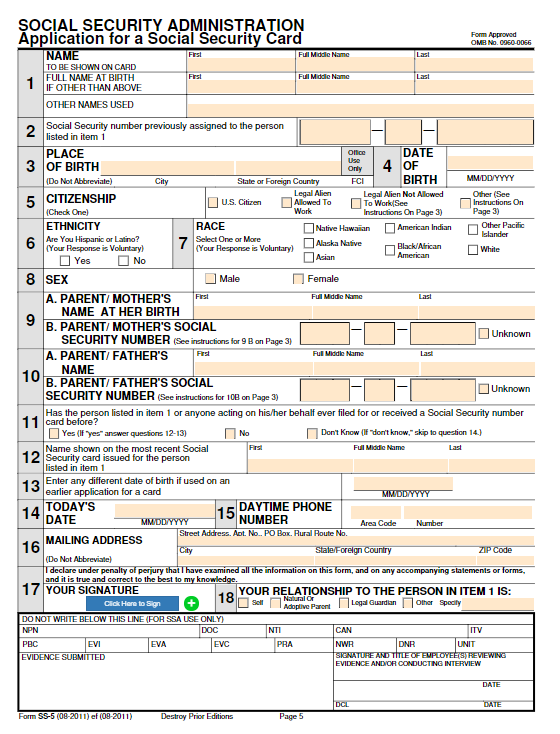A Social Security Number (SSN) is a unique piece of valuable information used as proof of your identity. It is necessary for legal transactions, including but not limited to applying for a job, opening bank accounts, and receiving retirement benefits. The powerful nine-digit number combination is assigned by the U.S. government to all U.S. citizens and eligible U.S. residents to track their income and number of years worked and determine their benefits.
If you get hired for a new job, your employer will need your SSN to report your income to the Internal Revenue Service (IRS), a U.S. federal agency responsible for the collection of taxes and enforcement of tax laws, and your Social Security wages to the Social Security Administration (IRS), a U.S. government agency that supervises and administers the Social Security program in the country.
In general, parents procure an SSN for their children to open bank accounts in their names, enroll them for medical coverage, or claim government services for children. Nevertheless, if you have never had one or need to apply for a new one for legal reasons, you need to fill out Form SS-5 to apply for and receive a new Social Security card with your SSN.
Am I qualified to apply for a Social Security card?
Before completing and submitting Form SS-5, make sure you fall under one of these conditions:
- You have never received a Social Security card before and need one.
- You lost or damaged your old card beyond repair.
- Your old Social Security card has an error.
- You have changed your citizenship or residency status from a legal resident to a U.S. citizen.
- You have changed your name due to marriage, divorce, or any legal reason.
- You have given birth or adopted a child and want to obtain a Social Security card for him or her.
- You have an adult-dependent and need a Social Security card for him or her for government benefits and financial management.
How to fill out Form SS-5?
To get a copy of Form SS-5, you can visit the official SSA website, visit your local Social Security office, or download the form from an online library of legal forms.
Form SS-5 is a single-page form with additional pages for instructions. Provide all the required information, ensuring that there are no errors to avoid any delay in your application.
Follow the instructions to answer Form SS-5 correctly:
Section 1 requires your full legal name that would appear on your Social Security card. Provide the name you had before you changed your name due to a legal purpose, if applicable.
Section 2 requires the SSN previously assigned to you, if applicable.
Section 3 requires your place of birth. Regardless if it is within or outside the U.S., do not abbreviate.
Section 4 requires your date of birth.
Section 5 requires you to select one of the options to determine your citizenship. There are conditions for some of the options, make sure to read and follow the instructions provided carefully.
Section 6 asks you to determine if you are Hispanic or Latino. Answering this section is voluntary, will only be for statistical purposes. It will not affect your application.
Section 7 asks for your race. Answering this section is voluntary, will only be for statistical purposes. It will not affect your application.
Section 8 requires your gender.
Section 9 requires your mother’s full name at the time of her birth and her SSN. If SSN is not known, check the “Unknown” box.
Section 10 requires your father’s full name and his SSN. If SSN is not known, check the “Unknown” box.
Section 11 asks if you have filed or received an SSN before. If yes, answer Sections 12 to 13.
Section 12 requires your name as shown on your most recent Social Security card.
Section 13 requires your date of birth if you previously changed it due to an error. Leave this section unanswered if your card shows your correct date of birth.
Section 14 requires the date of application.
Section 15 requires your daytime phone number that the SSA can use to contact you.
Section 16 requires your mailing address that the SSA can use to mail your Social Security card.
Section 17 requires your signature to certify the application.
Section 18 asks for your relationship to the person in Section 1, if applicable.
What are the required documents?
You always need to submit supporting documents regardless of the purpose of your application. Take note that the SSA does not accept photocopies and only allows original or copies certified by the issuing agency of the document. A notarized photocopy of an original document is also not acceptable.
Provide documents that prove identity, age, and citizenship status. For a complete list of accepted documents, you may refer to the Evidence Documents section of Form SS-5.
How to submit Form SS-5?
Depending on your age and the purpose of the application, you may either mail the form with the supporting documents to your local Social Security office, visit a nearby Social Security office, or submit a request online.
First-time applicants above the age of 12 need to visit a Social Security office for an interview. An interview enables the SSA to ensure that you have never been issued a card or number before.
If you are requesting a replacement card, you can apply online via the official SSA website. However, this service is unavailable to residents of the following states: Alabama, Alaska, Connecticut, Hawaii, Kansas, Minnesota, Nevada, New Hampshire, North Carolina, Ohio, Oklahoma, Oregon, South Carolina, Tennessee, Utah, and West Virginia. In addition, it is unavailable in U.S. territories, such as Guam, Northern Mariana Islands, Puerto Rico, or the U.S. Virgin Islands. The online application requires that an individual must be at least 18 and not requesting a name change.
Once the application is complete, your Social Security card will arrive after around 10 business days. Take care of your card as a public law limits the replacement of Social Security cards to three per calendar year and 10 in a lifetime, except for special cases.





